Report on Organisational Management: Key Functions and Structures
VerifiedAdded on 2023/01/18
|12
|2985
|92
Report
AI Summary
This report provides a comprehensive overview of organisational management, exploring its core functions and structures. It delves into the critical roles of Human Resource Management (HRM), including its aims of ensuring organizational success through people, and its impact on organizational effectiveness, human capital management, knowledge management, reward management, and employee relations. The report also examines the marketing function, discussing its role in creating customer relationships and covering the marketing mix (product, price, place, and promotion). Furthermore, it analyzes the contribution of effective organizational structure to the success and growth of a business, highlighting the issues raised by ineffective structures and emphasizing the importance of well-defined structures for better communication, clear reporting, and overall organizational success. The report concludes by underscoring the significance of adapting to a changing environment for sustainable growth.
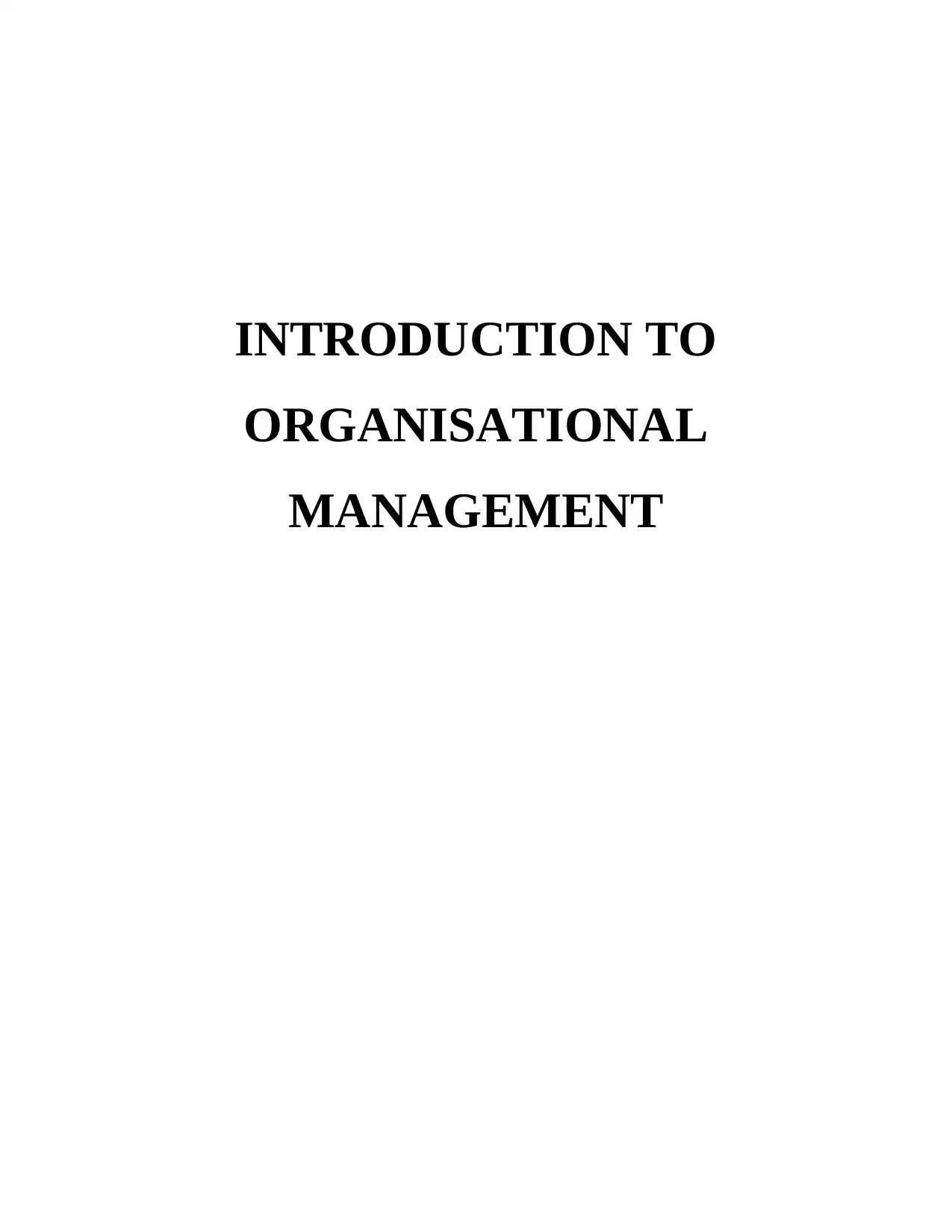
INTRODUCTION TO
ORGANISATIONAL
MANAGEMENT
ORGANISATIONAL
MANAGEMENT
Paraphrase This Document
Need a fresh take? Get an instant paraphrase of this document with our AI Paraphraser
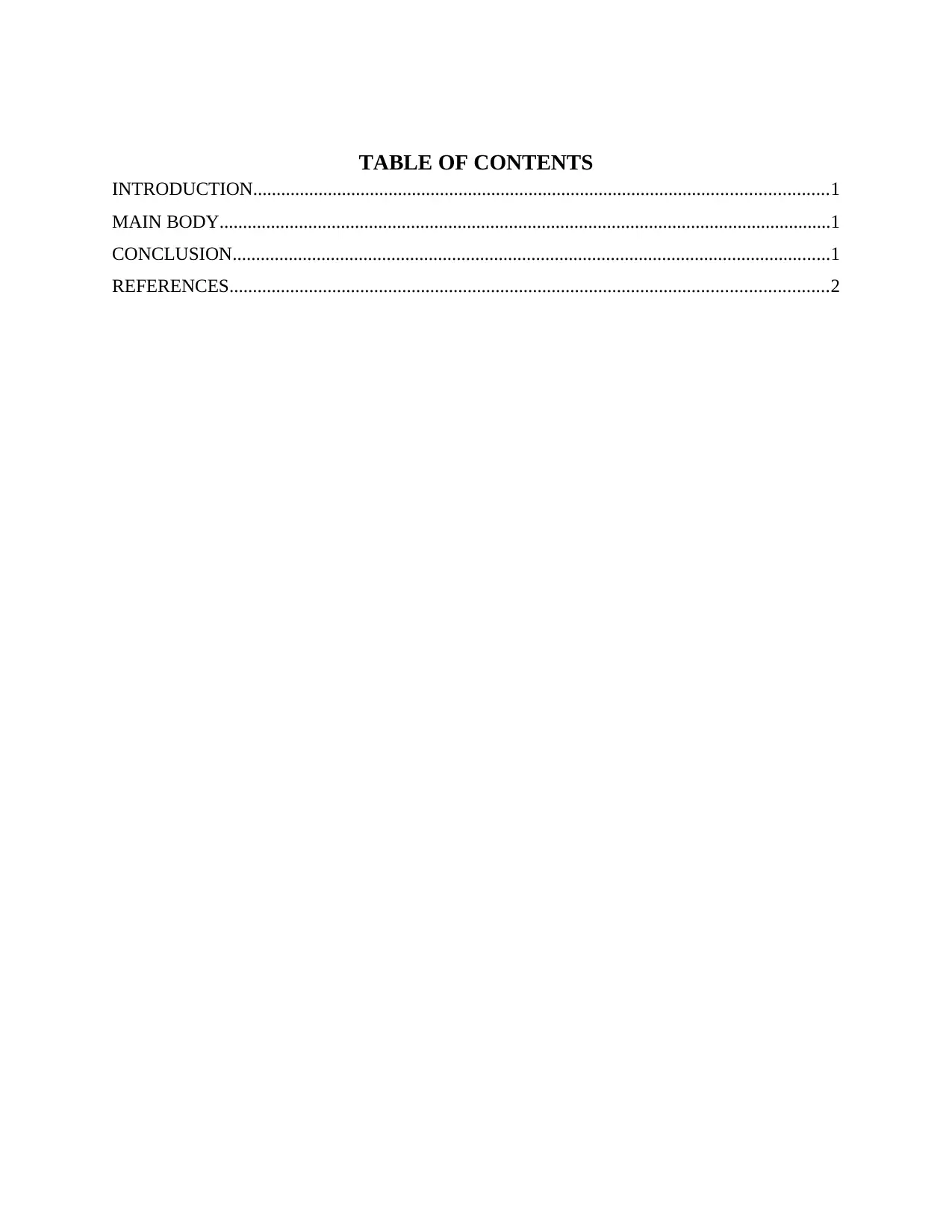
TABLE OF CONTENTS
INTRODUCTION...........................................................................................................................1
MAIN BODY...................................................................................................................................1
CONCLUSION................................................................................................................................1
REFERENCES................................................................................................................................2
INTRODUCTION...........................................................................................................................1
MAIN BODY...................................................................................................................................1
CONCLUSION................................................................................................................................1
REFERENCES................................................................................................................................2
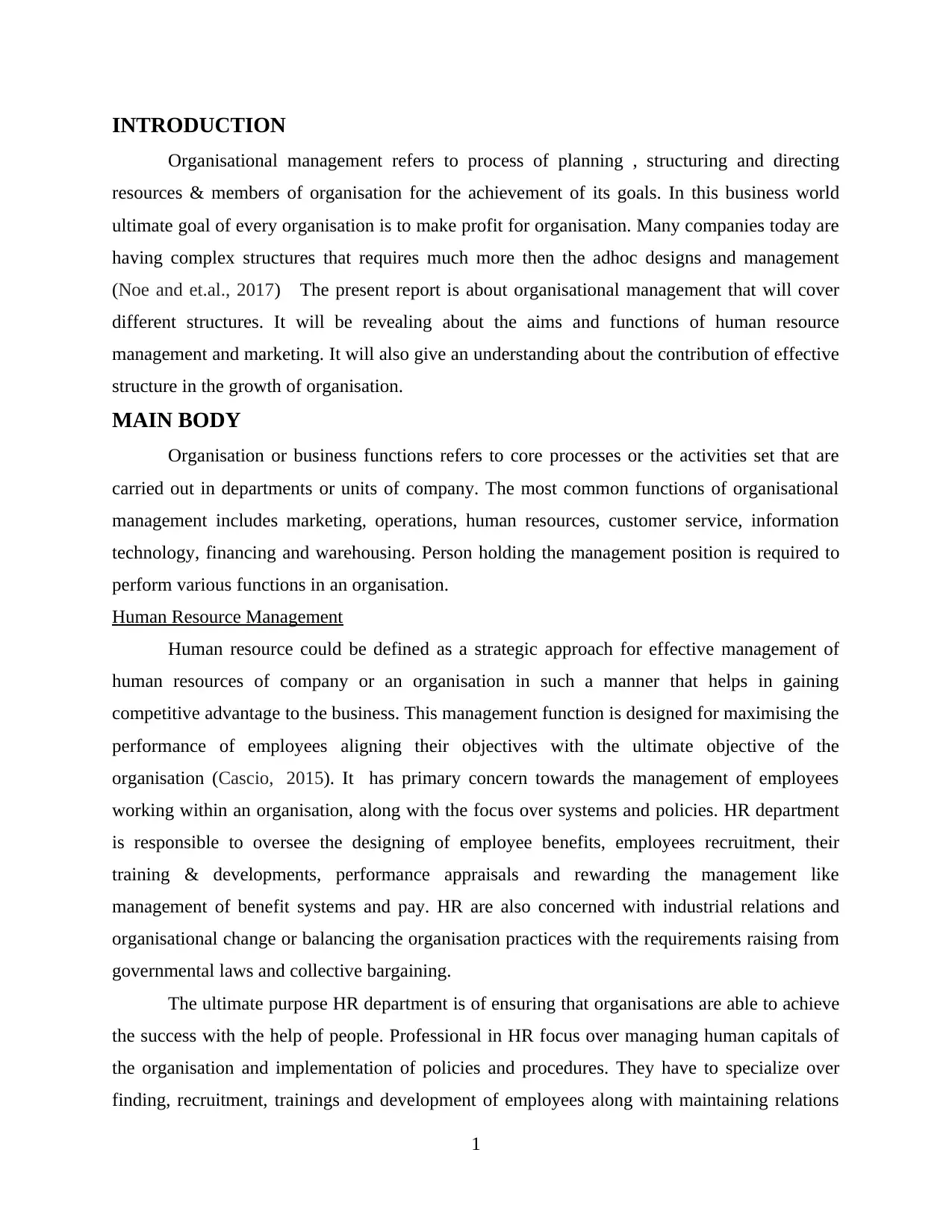
INTRODUCTION
Organisational management refers to process of planning , structuring and directing
resources & members of organisation for the achievement of its goals. In this business world
ultimate goal of every organisation is to make profit for organisation. Many companies today are
having complex structures that requires much more then the adhoc designs and management
(Noe and et.al., 2017) The present report is about organisational management that will cover
different structures. It will be revealing about the aims and functions of human resource
management and marketing. It will also give an understanding about the contribution of effective
structure in the growth of organisation.
MAIN BODY
Organisation or business functions refers to core processes or the activities set that are
carried out in departments or units of company. The most common functions of organisational
management includes marketing, operations, human resources, customer service, information
technology, financing and warehousing. Person holding the management position is required to
perform various functions in an organisation.
Human Resource Management
Human resource could be defined as a strategic approach for effective management of
human resources of company or an organisation in such a manner that helps in gaining
competitive advantage to the business. This management function is designed for maximising the
performance of employees aligning their objectives with the ultimate objective of the
organisation (Cascio, 2015). It has primary concern towards the management of employees
working within an organisation, along with the focus over systems and policies. HR department
is responsible to oversee the designing of employee benefits, employees recruitment, their
training & developments, performance appraisals and rewarding the management like
management of benefit systems and pay. HR are also concerned with industrial relations and
organisational change or balancing the organisation practices with the requirements raising from
governmental laws and collective bargaining.
The ultimate purpose HR department is of ensuring that organisations are able to achieve
the success with the help of people. Professional in HR focus over managing human capitals of
the organisation and implementation of policies and procedures. They have to specialize over
finding, recruitment, trainings and development of employees along with maintaining relations
1
Organisational management refers to process of planning , structuring and directing
resources & members of organisation for the achievement of its goals. In this business world
ultimate goal of every organisation is to make profit for organisation. Many companies today are
having complex structures that requires much more then the adhoc designs and management
(Noe and et.al., 2017) The present report is about organisational management that will cover
different structures. It will be revealing about the aims and functions of human resource
management and marketing. It will also give an understanding about the contribution of effective
structure in the growth of organisation.
MAIN BODY
Organisation or business functions refers to core processes or the activities set that are
carried out in departments or units of company. The most common functions of organisational
management includes marketing, operations, human resources, customer service, information
technology, financing and warehousing. Person holding the management position is required to
perform various functions in an organisation.
Human Resource Management
Human resource could be defined as a strategic approach for effective management of
human resources of company or an organisation in such a manner that helps in gaining
competitive advantage to the business. This management function is designed for maximising the
performance of employees aligning their objectives with the ultimate objective of the
organisation (Cascio, 2015). It has primary concern towards the management of employees
working within an organisation, along with the focus over systems and policies. HR department
is responsible to oversee the designing of employee benefits, employees recruitment, their
training & developments, performance appraisals and rewarding the management like
management of benefit systems and pay. HR are also concerned with industrial relations and
organisational change or balancing the organisation practices with the requirements raising from
governmental laws and collective bargaining.
The ultimate purpose HR department is of ensuring that organisations are able to achieve
the success with the help of people. Professional in HR focus over managing human capitals of
the organisation and implementation of policies and procedures. They have to specialize over
finding, recruitment, trainings and development of employees along with maintaining relations
1
⊘ This is a preview!⊘
Do you want full access?
Subscribe today to unlock all pages.

Trusted by 1+ million students worldwide
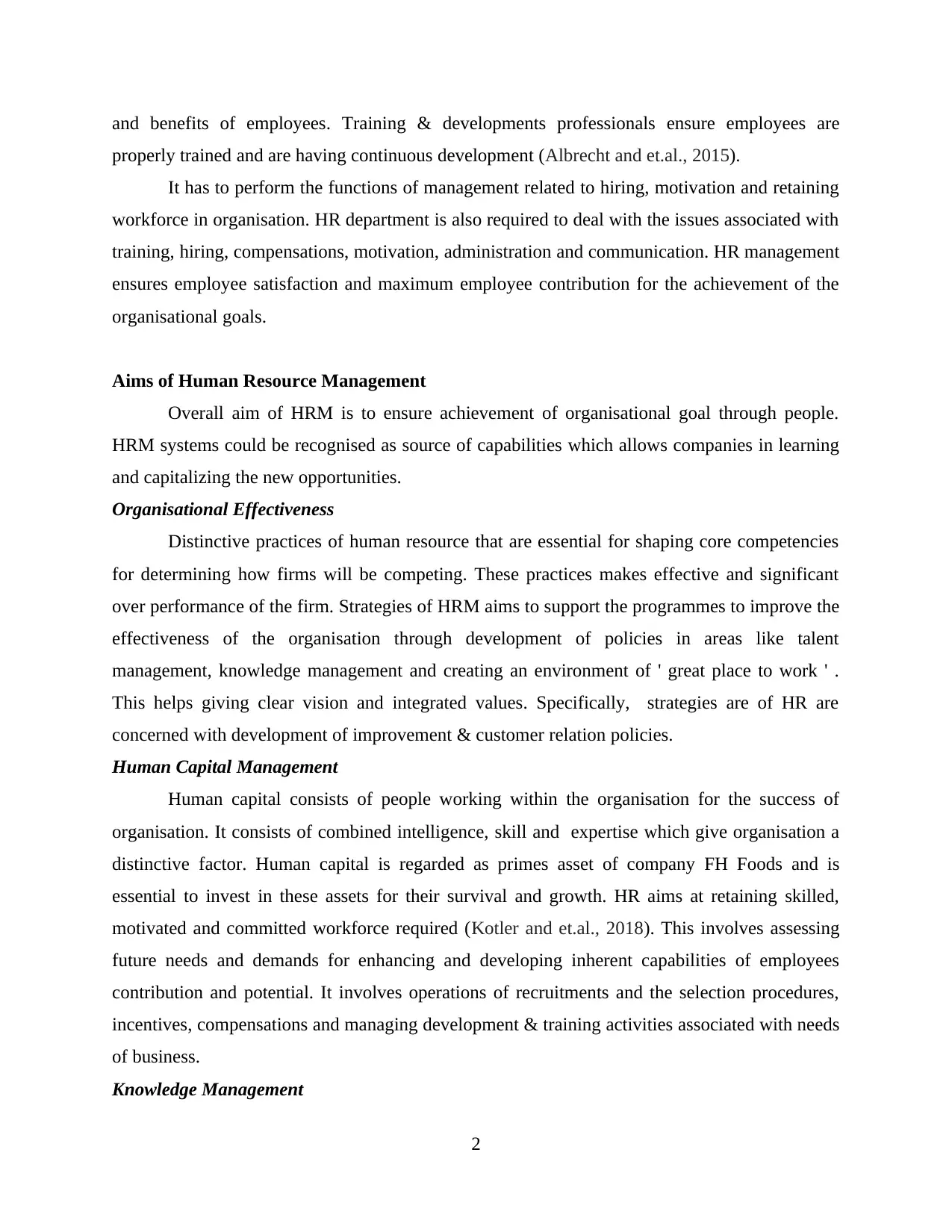
and benefits of employees. Training & developments professionals ensure employees are
properly trained and are having continuous development (Albrecht and et.al., 2015).
It has to perform the functions of management related to hiring, motivation and retaining
workforce in organisation. HR department is also required to deal with the issues associated with
training, hiring, compensations, motivation, administration and communication. HR management
ensures employee satisfaction and maximum employee contribution for the achievement of the
organisational goals.
Aims of Human Resource Management
Overall aim of HRM is to ensure achievement of organisational goal through people.
HRM systems could be recognised as source of capabilities which allows companies in learning
and capitalizing the new opportunities.
Organisational Effectiveness
Distinctive practices of human resource that are essential for shaping core competencies
for determining how firms will be competing. These practices makes effective and significant
over performance of the firm. Strategies of HRM aims to support the programmes to improve the
effectiveness of the organisation through development of policies in areas like talent
management, knowledge management and creating an environment of ' great place to work ' .
This helps giving clear vision and integrated values. Specifically, strategies are of HR are
concerned with development of improvement & customer relation policies.
Human Capital Management
Human capital consists of people working within the organisation for the success of
organisation. It consists of combined intelligence, skill and expertise which give organisation a
distinctive factor. Human capital is regarded as primes asset of company FH Foods and is
essential to invest in these assets for their survival and growth. HR aims at retaining skilled,
motivated and committed workforce required (Kotler and et.al., 2018). This involves assessing
future needs and demands for enhancing and developing inherent capabilities of employees
contribution and potential. It involves operations of recruitments and the selection procedures,
incentives, compensations and managing development & training activities associated with needs
of business.
Knowledge Management
2
properly trained and are having continuous development (Albrecht and et.al., 2015).
It has to perform the functions of management related to hiring, motivation and retaining
workforce in organisation. HR department is also required to deal with the issues associated with
training, hiring, compensations, motivation, administration and communication. HR management
ensures employee satisfaction and maximum employee contribution for the achievement of the
organisational goals.
Aims of Human Resource Management
Overall aim of HRM is to ensure achievement of organisational goal through people.
HRM systems could be recognised as source of capabilities which allows companies in learning
and capitalizing the new opportunities.
Organisational Effectiveness
Distinctive practices of human resource that are essential for shaping core competencies
for determining how firms will be competing. These practices makes effective and significant
over performance of the firm. Strategies of HRM aims to support the programmes to improve the
effectiveness of the organisation through development of policies in areas like talent
management, knowledge management and creating an environment of ' great place to work ' .
This helps giving clear vision and integrated values. Specifically, strategies are of HR are
concerned with development of improvement & customer relation policies.
Human Capital Management
Human capital consists of people working within the organisation for the success of
organisation. It consists of combined intelligence, skill and expertise which give organisation a
distinctive factor. Human capital is regarded as primes asset of company FH Foods and is
essential to invest in these assets for their survival and growth. HR aims at retaining skilled,
motivated and committed workforce required (Kotler and et.al., 2018). This involves assessing
future needs and demands for enhancing and developing inherent capabilities of employees
contribution and potential. It involves operations of recruitments and the selection procedures,
incentives, compensations and managing development & training activities associated with needs
of business.
Knowledge Management
2
Paraphrase This Document
Need a fresh take? Get an instant paraphrase of this document with our AI Paraphraser
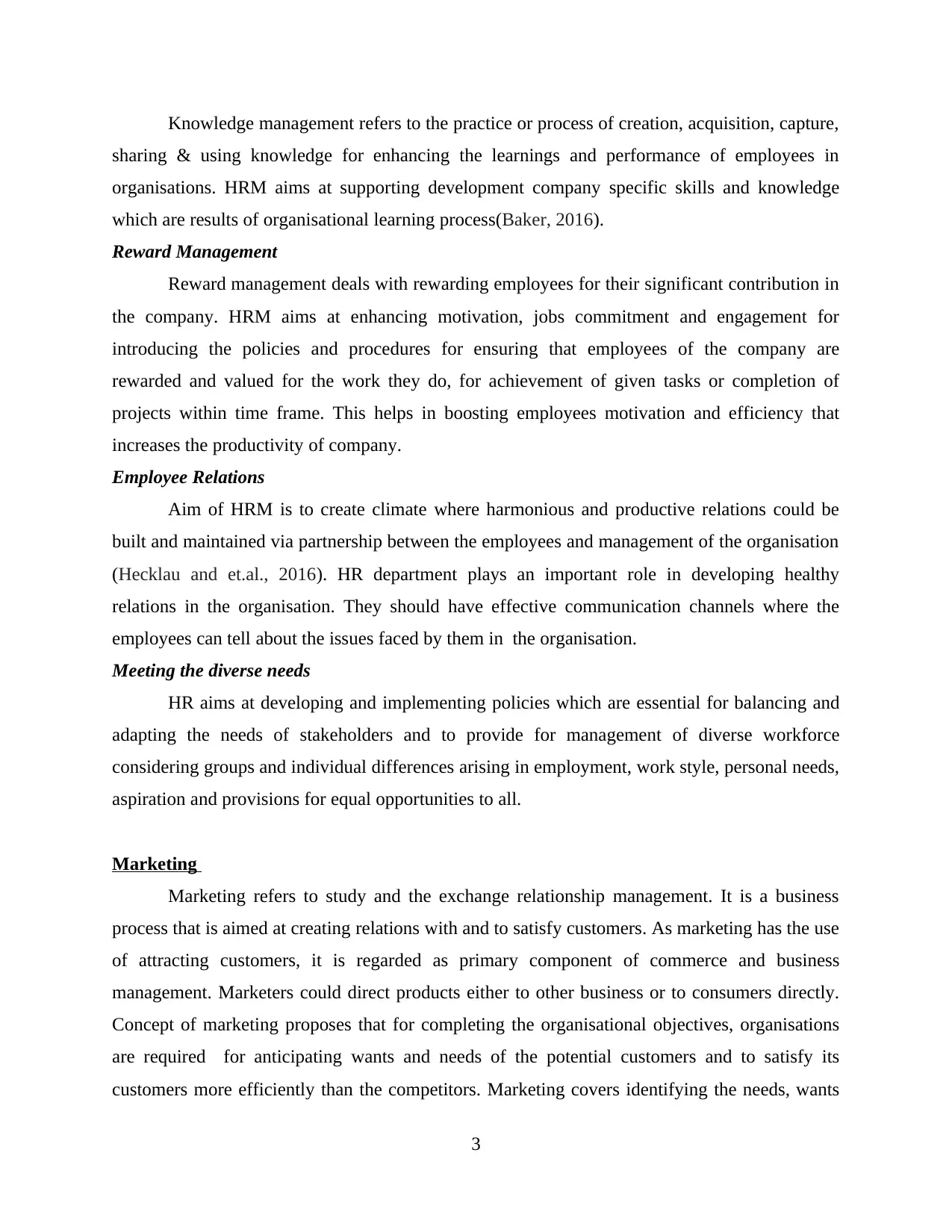
Knowledge management refers to the practice or process of creation, acquisition, capture,
sharing & using knowledge for enhancing the learnings and performance of employees in
organisations. HRM aims at supporting development company specific skills and knowledge
which are results of organisational learning process(Baker, 2016).
Reward Management
Reward management deals with rewarding employees for their significant contribution in
the company. HRM aims at enhancing motivation, jobs commitment and engagement for
introducing the policies and procedures for ensuring that employees of the company are
rewarded and valued for the work they do, for achievement of given tasks or completion of
projects within time frame. This helps in boosting employees motivation and efficiency that
increases the productivity of company.
Employee Relations
Aim of HRM is to create climate where harmonious and productive relations could be
built and maintained via partnership between the employees and management of the organisation
(Hecklau and et.al., 2016). HR department plays an important role in developing healthy
relations in the organisation. They should have effective communication channels where the
employees can tell about the issues faced by them in the organisation.
Meeting the diverse needs
HR aims at developing and implementing policies which are essential for balancing and
adapting the needs of stakeholders and to provide for management of diverse workforce
considering groups and individual differences arising in employment, work style, personal needs,
aspiration and provisions for equal opportunities to all.
Marketing
Marketing refers to study and the exchange relationship management. It is a business
process that is aimed at creating relations with and to satisfy customers. As marketing has the use
of attracting customers, it is regarded as primary component of commerce and business
management. Marketers could direct products either to other business or to consumers directly.
Concept of marketing proposes that for completing the organisational objectives, organisations
are required for anticipating wants and needs of the potential customers and to satisfy its
customers more efficiently than the competitors. Marketing covers identifying the needs, wants
3
sharing & using knowledge for enhancing the learnings and performance of employees in
organisations. HRM aims at supporting development company specific skills and knowledge
which are results of organisational learning process(Baker, 2016).
Reward Management
Reward management deals with rewarding employees for their significant contribution in
the company. HRM aims at enhancing motivation, jobs commitment and engagement for
introducing the policies and procedures for ensuring that employees of the company are
rewarded and valued for the work they do, for achievement of given tasks or completion of
projects within time frame. This helps in boosting employees motivation and efficiency that
increases the productivity of company.
Employee Relations
Aim of HRM is to create climate where harmonious and productive relations could be
built and maintained via partnership between the employees and management of the organisation
(Hecklau and et.al., 2016). HR department plays an important role in developing healthy
relations in the organisation. They should have effective communication channels where the
employees can tell about the issues faced by them in the organisation.
Meeting the diverse needs
HR aims at developing and implementing policies which are essential for balancing and
adapting the needs of stakeholders and to provide for management of diverse workforce
considering groups and individual differences arising in employment, work style, personal needs,
aspiration and provisions for equal opportunities to all.
Marketing
Marketing refers to study and the exchange relationship management. It is a business
process that is aimed at creating relations with and to satisfy customers. As marketing has the use
of attracting customers, it is regarded as primary component of commerce and business
management. Marketers could direct products either to other business or to consumers directly.
Concept of marketing proposes that for completing the organisational objectives, organisations
are required for anticipating wants and needs of the potential customers and to satisfy its
customers more efficiently than the competitors. Marketing covers identifying the needs, wants
3
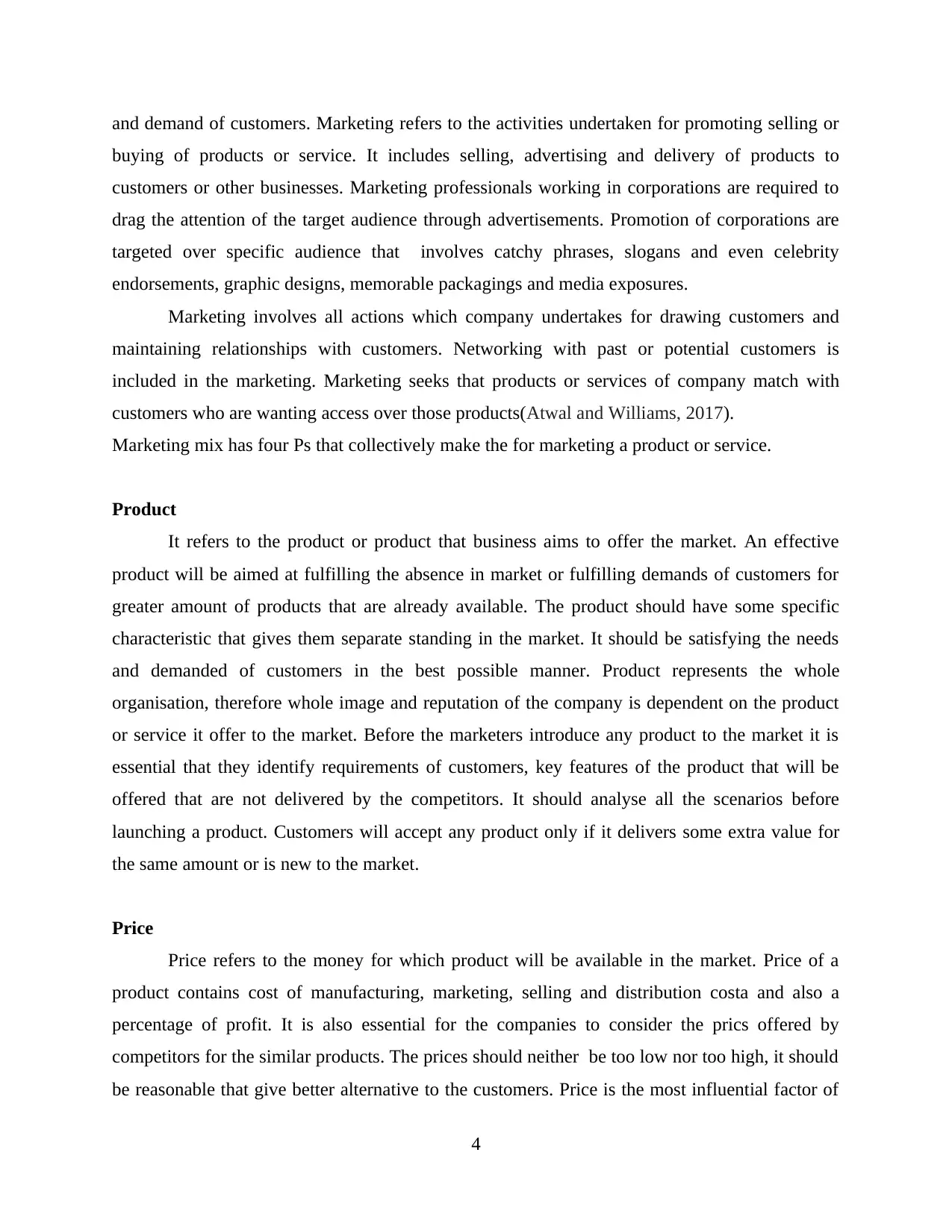
and demand of customers. Marketing refers to the activities undertaken for promoting selling or
buying of products or service. It includes selling, advertising and delivery of products to
customers or other businesses. Marketing professionals working in corporations are required to
drag the attention of the target audience through advertisements. Promotion of corporations are
targeted over specific audience that involves catchy phrases, slogans and even celebrity
endorsements, graphic designs, memorable packagings and media exposures.
Marketing involves all actions which company undertakes for drawing customers and
maintaining relationships with customers. Networking with past or potential customers is
included in the marketing. Marketing seeks that products or services of company match with
customers who are wanting access over those products(Atwal and Williams, 2017).
Marketing mix has four Ps that collectively make the for marketing a product or service.
Product
It refers to the product or product that business aims to offer the market. An effective
product will be aimed at fulfilling the absence in market or fulfilling demands of customers for
greater amount of products that are already available. The product should have some specific
characteristic that gives them separate standing in the market. It should be satisfying the needs
and demanded of customers in the best possible manner. Product represents the whole
organisation, therefore whole image and reputation of the company is dependent on the product
or service it offer to the market. Before the marketers introduce any product to the market it is
essential that they identify requirements of customers, key features of the product that will be
offered that are not delivered by the competitors. It should analyse all the scenarios before
launching a product. Customers will accept any product only if it delivers some extra value for
the same amount or is new to the market.
Price
Price refers to the money for which product will be available in the market. Price of a
product contains cost of manufacturing, marketing, selling and distribution costa and also a
percentage of profit. It is also essential for the companies to consider the prics offered by
competitors for the similar products. The prices should neither be too low nor too high, it should
be reasonable that give better alternative to the customers. Price is the most influential factor of
4
buying of products or service. It includes selling, advertising and delivery of products to
customers or other businesses. Marketing professionals working in corporations are required to
drag the attention of the target audience through advertisements. Promotion of corporations are
targeted over specific audience that involves catchy phrases, slogans and even celebrity
endorsements, graphic designs, memorable packagings and media exposures.
Marketing involves all actions which company undertakes for drawing customers and
maintaining relationships with customers. Networking with past or potential customers is
included in the marketing. Marketing seeks that products or services of company match with
customers who are wanting access over those products(Atwal and Williams, 2017).
Marketing mix has four Ps that collectively make the for marketing a product or service.
Product
It refers to the product or product that business aims to offer the market. An effective
product will be aimed at fulfilling the absence in market or fulfilling demands of customers for
greater amount of products that are already available. The product should have some specific
characteristic that gives them separate standing in the market. It should be satisfying the needs
and demanded of customers in the best possible manner. Product represents the whole
organisation, therefore whole image and reputation of the company is dependent on the product
or service it offer to the market. Before the marketers introduce any product to the market it is
essential that they identify requirements of customers, key features of the product that will be
offered that are not delivered by the competitors. It should analyse all the scenarios before
launching a product. Customers will accept any product only if it delivers some extra value for
the same amount or is new to the market.
Price
Price refers to the money for which product will be available in the market. Price of a
product contains cost of manufacturing, marketing, selling and distribution costa and also a
percentage of profit. It is also essential for the companies to consider the prics offered by
competitors for the similar products. The prices should neither be too low nor too high, it should
be reasonable that give better alternative to the customers. Price is the most influential factor of
4
⊘ This is a preview!⊘
Do you want full access?
Subscribe today to unlock all pages.

Trusted by 1+ million students worldwide
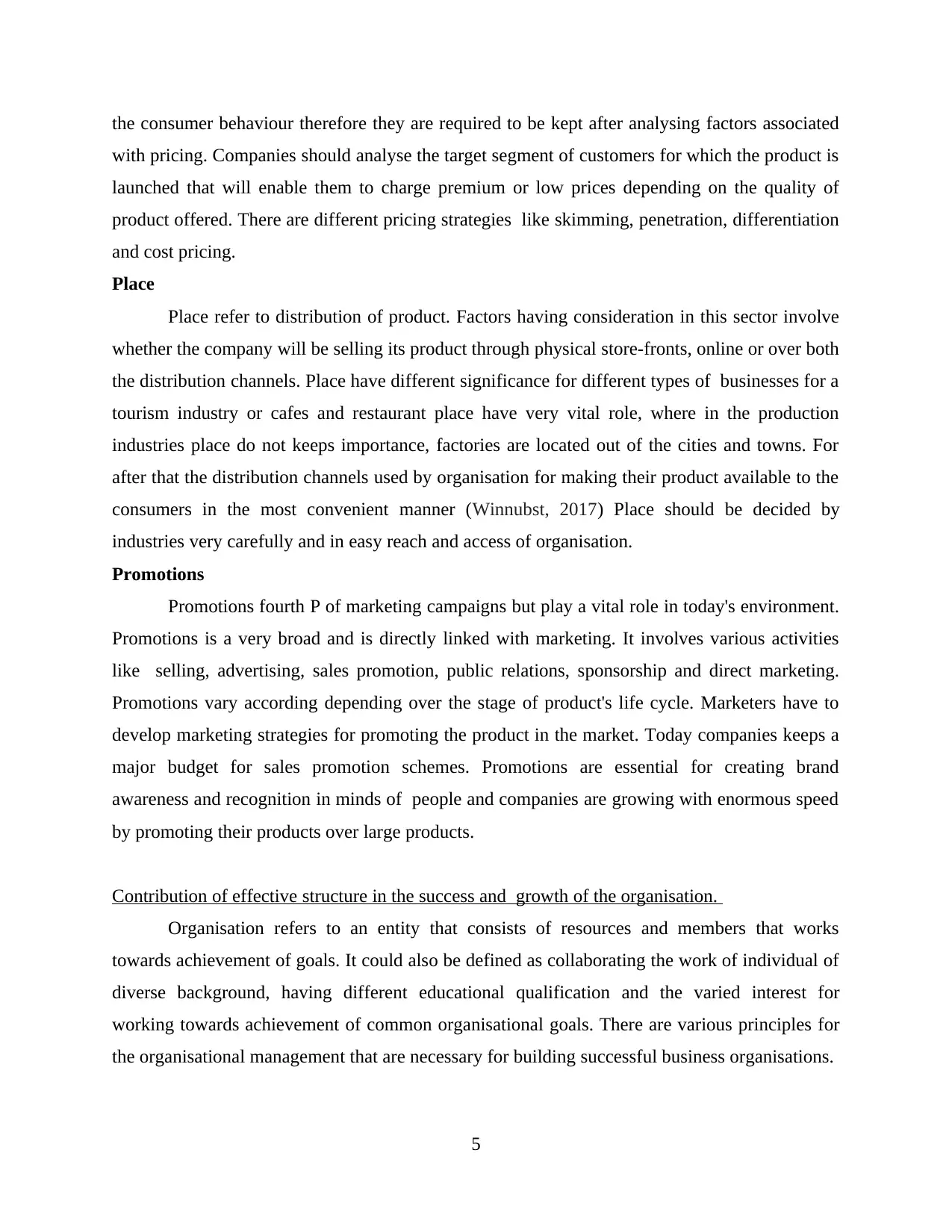
the consumer behaviour therefore they are required to be kept after analysing factors associated
with pricing. Companies should analyse the target segment of customers for which the product is
launched that will enable them to charge premium or low prices depending on the quality of
product offered. There are different pricing strategies like skimming, penetration, differentiation
and cost pricing.
Place
Place refer to distribution of product. Factors having consideration in this sector involve
whether the company will be selling its product through physical store-fronts, online or over both
the distribution channels. Place have different significance for different types of businesses for a
tourism industry or cafes and restaurant place have very vital role, where in the production
industries place do not keeps importance, factories are located out of the cities and towns. For
after that the distribution channels used by organisation for making their product available to the
consumers in the most convenient manner (Winnubst, 2017) Place should be decided by
industries very carefully and in easy reach and access of organisation.
Promotions
Promotions fourth P of marketing campaigns but play a vital role in today's environment.
Promotions is a very broad and is directly linked with marketing. It involves various activities
like selling, advertising, sales promotion, public relations, sponsorship and direct marketing.
Promotions vary according depending over the stage of product's life cycle. Marketers have to
develop marketing strategies for promoting the product in the market. Today companies keeps a
major budget for sales promotion schemes. Promotions are essential for creating brand
awareness and recognition in minds of people and companies are growing with enormous speed
by promoting their products over large products.
Contribution of effective structure in the success and growth of the organisation.
Organisation refers to an entity that consists of resources and members that works
towards achievement of goals. It could also be defined as collaborating the work of individual of
diverse background, having different educational qualification and the varied interest for
working towards achievement of common organisational goals. There are various principles for
the organisational management that are necessary for building successful business organisations.
5
with pricing. Companies should analyse the target segment of customers for which the product is
launched that will enable them to charge premium or low prices depending on the quality of
product offered. There are different pricing strategies like skimming, penetration, differentiation
and cost pricing.
Place
Place refer to distribution of product. Factors having consideration in this sector involve
whether the company will be selling its product through physical store-fronts, online or over both
the distribution channels. Place have different significance for different types of businesses for a
tourism industry or cafes and restaurant place have very vital role, where in the production
industries place do not keeps importance, factories are located out of the cities and towns. For
after that the distribution channels used by organisation for making their product available to the
consumers in the most convenient manner (Winnubst, 2017) Place should be decided by
industries very carefully and in easy reach and access of organisation.
Promotions
Promotions fourth P of marketing campaigns but play a vital role in today's environment.
Promotions is a very broad and is directly linked with marketing. It involves various activities
like selling, advertising, sales promotion, public relations, sponsorship and direct marketing.
Promotions vary according depending over the stage of product's life cycle. Marketers have to
develop marketing strategies for promoting the product in the market. Today companies keeps a
major budget for sales promotion schemes. Promotions are essential for creating brand
awareness and recognition in minds of people and companies are growing with enormous speed
by promoting their products over large products.
Contribution of effective structure in the success and growth of the organisation.
Organisation refers to an entity that consists of resources and members that works
towards achievement of goals. It could also be defined as collaborating the work of individual of
diverse background, having different educational qualification and the varied interest for
working towards achievement of common organisational goals. There are various principles for
the organisational management that are necessary for building successful business organisations.
5
Paraphrase This Document
Need a fresh take? Get an instant paraphrase of this document with our AI Paraphraser
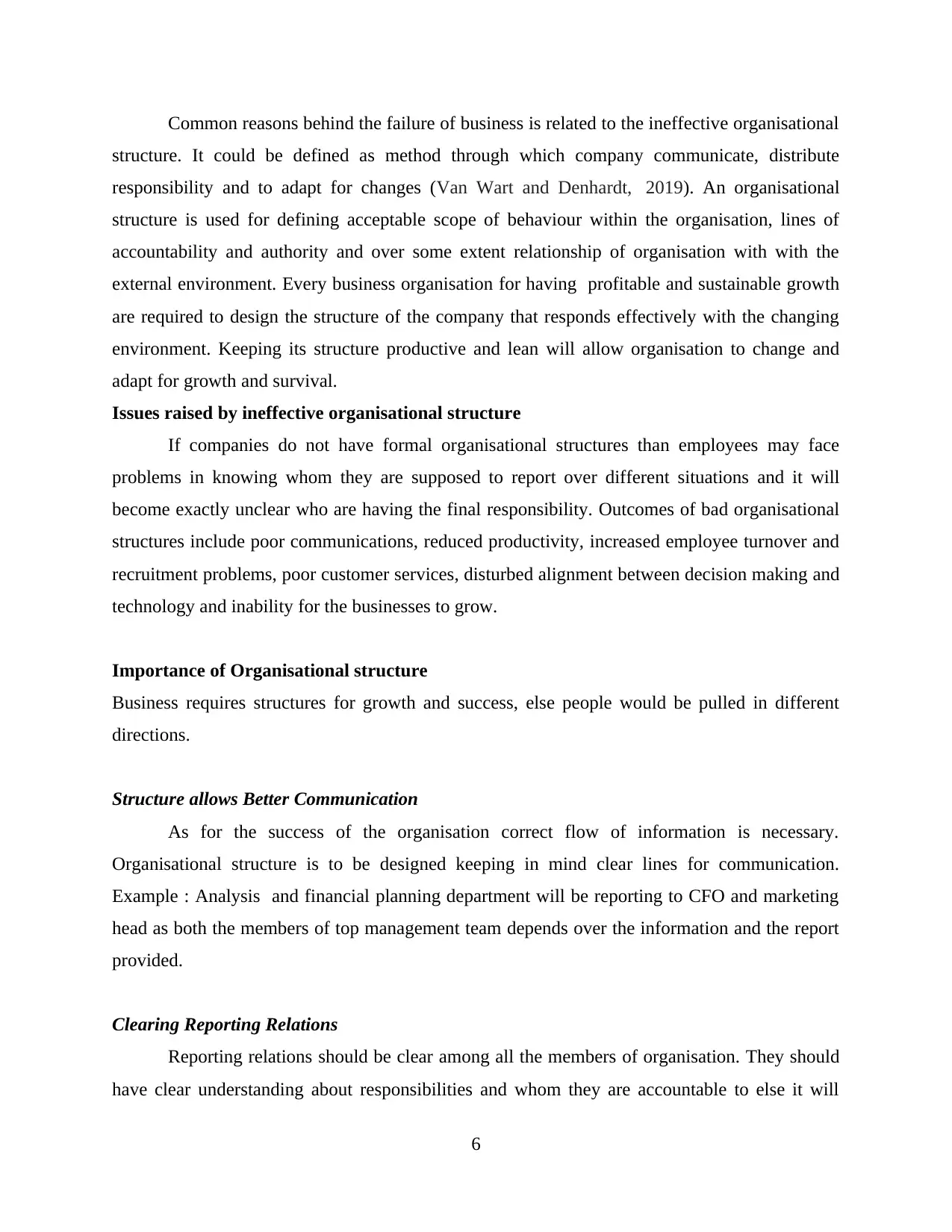
Common reasons behind the failure of business is related to the ineffective organisational
structure. It could be defined as method through which company communicate, distribute
responsibility and to adapt for changes (Van Wart and Denhardt, 2019). An organisational
structure is used for defining acceptable scope of behaviour within the organisation, lines of
accountability and authority and over some extent relationship of organisation with with the
external environment. Every business organisation for having profitable and sustainable growth
are required to design the structure of the company that responds effectively with the changing
environment. Keeping its structure productive and lean will allow organisation to change and
adapt for growth and survival.
Issues raised by ineffective organisational structure
If companies do not have formal organisational structures than employees may face
problems in knowing whom they are supposed to report over different situations and it will
become exactly unclear who are having the final responsibility. Outcomes of bad organisational
structures include poor communications, reduced productivity, increased employee turnover and
recruitment problems, poor customer services, disturbed alignment between decision making and
technology and inability for the businesses to grow.
Importance of Organisational structure
Business requires structures for growth and success, else people would be pulled in different
directions.
Structure allows Better Communication
As for the success of the organisation correct flow of information is necessary.
Organisational structure is to be designed keeping in mind clear lines for communication.
Example : Analysis and financial planning department will be reporting to CFO and marketing
head as both the members of top management team depends over the information and the report
provided.
Clearing Reporting Relations
Reporting relations should be clear among all the members of organisation. They should
have clear understanding about responsibilities and whom they are accountable to else it will
6
structure. It could be defined as method through which company communicate, distribute
responsibility and to adapt for changes (Van Wart and Denhardt, 2019). An organisational
structure is used for defining acceptable scope of behaviour within the organisation, lines of
accountability and authority and over some extent relationship of organisation with with the
external environment. Every business organisation for having profitable and sustainable growth
are required to design the structure of the company that responds effectively with the changing
environment. Keeping its structure productive and lean will allow organisation to change and
adapt for growth and survival.
Issues raised by ineffective organisational structure
If companies do not have formal organisational structures than employees may face
problems in knowing whom they are supposed to report over different situations and it will
become exactly unclear who are having the final responsibility. Outcomes of bad organisational
structures include poor communications, reduced productivity, increased employee turnover and
recruitment problems, poor customer services, disturbed alignment between decision making and
technology and inability for the businesses to grow.
Importance of Organisational structure
Business requires structures for growth and success, else people would be pulled in different
directions.
Structure allows Better Communication
As for the success of the organisation correct flow of information is necessary.
Organisational structure is to be designed keeping in mind clear lines for communication.
Example : Analysis and financial planning department will be reporting to CFO and marketing
head as both the members of top management team depends over the information and the report
provided.
Clearing Reporting Relations
Reporting relations should be clear among all the members of organisation. They should
have clear understanding about responsibilities and whom they are accountable to else it will
6
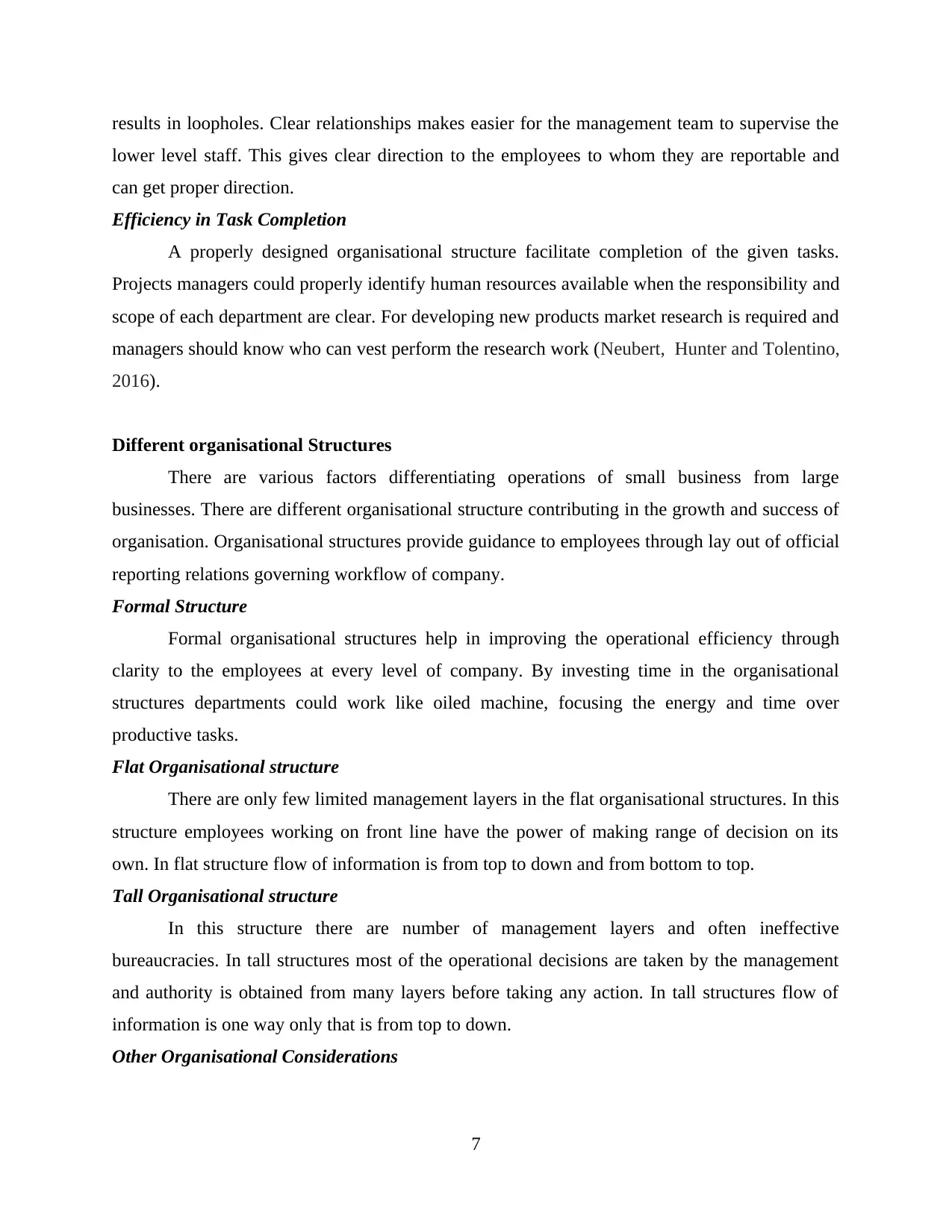
results in loopholes. Clear relationships makes easier for the management team to supervise the
lower level staff. This gives clear direction to the employees to whom they are reportable and
can get proper direction.
Efficiency in Task Completion
A properly designed organisational structure facilitate completion of the given tasks.
Projects managers could properly identify human resources available when the responsibility and
scope of each department are clear. For developing new products market research is required and
managers should know who can vest perform the research work (Neubert, Hunter and Tolentino,
2016).
Different organisational Structures
There are various factors differentiating operations of small business from large
businesses. There are different organisational structure contributing in the growth and success of
organisation. Organisational structures provide guidance to employees through lay out of official
reporting relations governing workflow of company.
Formal Structure
Formal organisational structures help in improving the operational efficiency through
clarity to the employees at every level of company. By investing time in the organisational
structures departments could work like oiled machine, focusing the energy and time over
productive tasks.
Flat Organisational structure
There are only few limited management layers in the flat organisational structures. In this
structure employees working on front line have the power of making range of decision on its
own. In flat structure flow of information is from top to down and from bottom to top.
Tall Organisational structure
In this structure there are number of management layers and often ineffective
bureaucracies. In tall structures most of the operational decisions are taken by the management
and authority is obtained from many layers before taking any action. In tall structures flow of
information is one way only that is from top to down.
Other Organisational Considerations
7
lower level staff. This gives clear direction to the employees to whom they are reportable and
can get proper direction.
Efficiency in Task Completion
A properly designed organisational structure facilitate completion of the given tasks.
Projects managers could properly identify human resources available when the responsibility and
scope of each department are clear. For developing new products market research is required and
managers should know who can vest perform the research work (Neubert, Hunter and Tolentino,
2016).
Different organisational Structures
There are various factors differentiating operations of small business from large
businesses. There are different organisational structure contributing in the growth and success of
organisation. Organisational structures provide guidance to employees through lay out of official
reporting relations governing workflow of company.
Formal Structure
Formal organisational structures help in improving the operational efficiency through
clarity to the employees at every level of company. By investing time in the organisational
structures departments could work like oiled machine, focusing the energy and time over
productive tasks.
Flat Organisational structure
There are only few limited management layers in the flat organisational structures. In this
structure employees working on front line have the power of making range of decision on its
own. In flat structure flow of information is from top to down and from bottom to top.
Tall Organisational structure
In this structure there are number of management layers and often ineffective
bureaucracies. In tall structures most of the operational decisions are taken by the management
and authority is obtained from many layers before taking any action. In tall structures flow of
information is one way only that is from top to down.
Other Organisational Considerations
7
⊘ This is a preview!⊘
Do you want full access?
Subscribe today to unlock all pages.

Trusted by 1+ million students worldwide
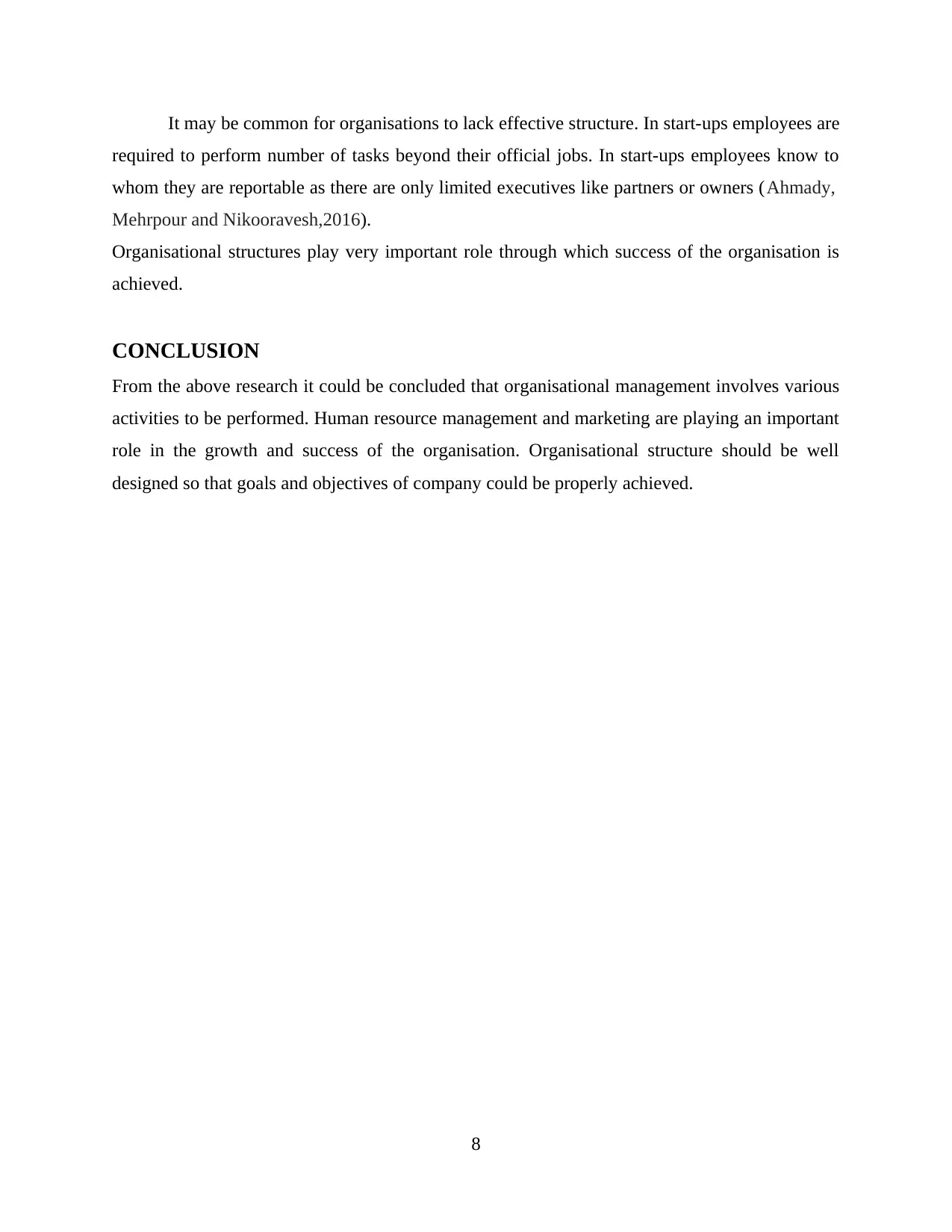
It may be common for organisations to lack effective structure. In start-ups employees are
required to perform number of tasks beyond their official jobs. In start-ups employees know to
whom they are reportable as there are only limited executives like partners or owners (Ahmady,
Mehrpour and Nikooravesh,2016).
Organisational structures play very important role through which success of the organisation is
achieved.
CONCLUSION
From the above research it could be concluded that organisational management involves various
activities to be performed. Human resource management and marketing are playing an important
role in the growth and success of the organisation. Organisational structure should be well
designed so that goals and objectives of company could be properly achieved.
8
required to perform number of tasks beyond their official jobs. In start-ups employees know to
whom they are reportable as there are only limited executives like partners or owners (Ahmady,
Mehrpour and Nikooravesh,2016).
Organisational structures play very important role through which success of the organisation is
achieved.
CONCLUSION
From the above research it could be concluded that organisational management involves various
activities to be performed. Human resource management and marketing are playing an important
role in the growth and success of the organisation. Organisational structure should be well
designed so that goals and objectives of company could be properly achieved.
8
Paraphrase This Document
Need a fresh take? Get an instant paraphrase of this document with our AI Paraphraser
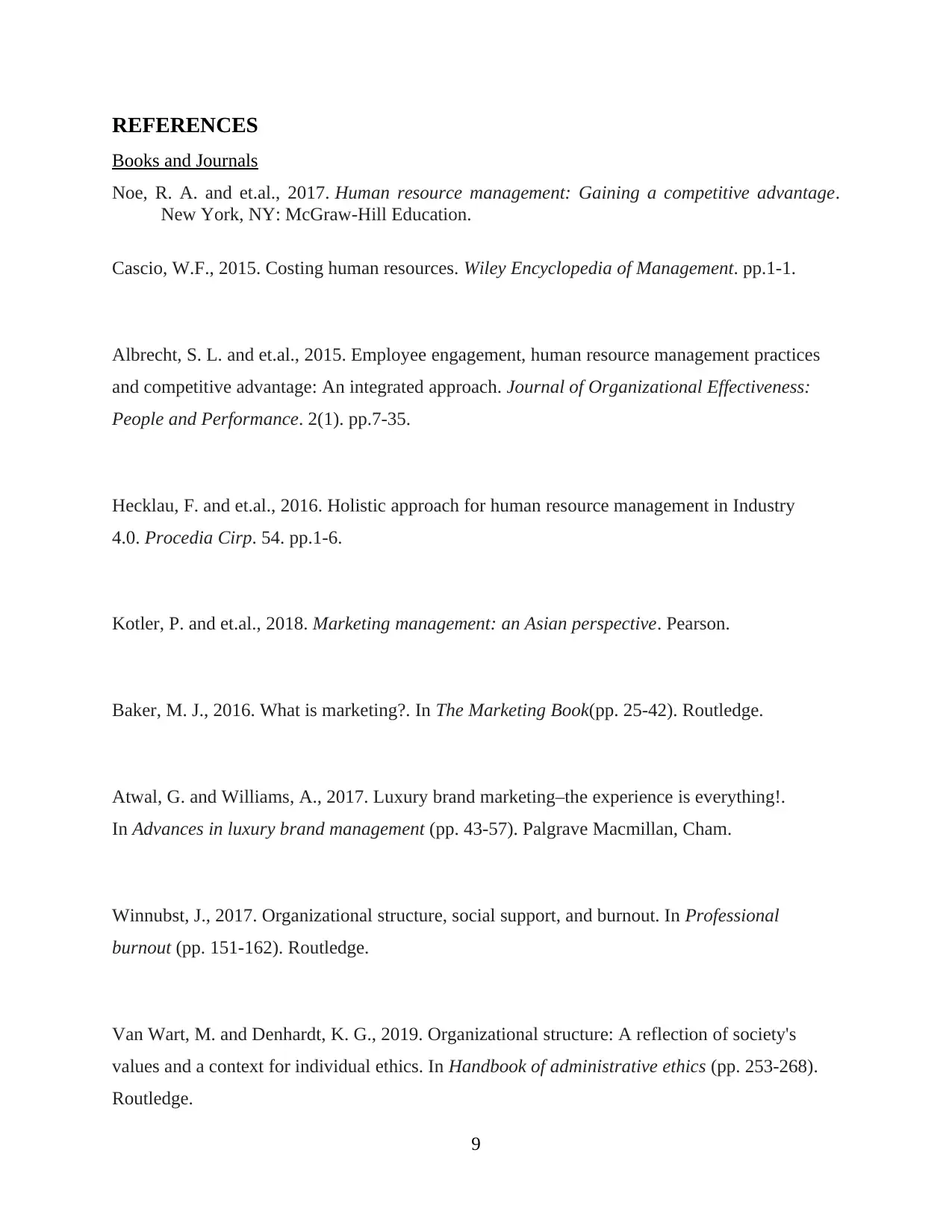
REFERENCES
Books and Journals
Noe, R. A. and et.al., 2017. Human resource management: Gaining a competitive advantage.
New York, NY: McGraw-Hill Education.
Cascio, W.F., 2015. Costing human resources. Wiley Encyclopedia of Management. pp.1-1.
Albrecht, S. L. and et.al., 2015. Employee engagement, human resource management practices
and competitive advantage: An integrated approach. Journal of Organizational Effectiveness:
People and Performance. 2(1). pp.7-35.
Hecklau, F. and et.al., 2016. Holistic approach for human resource management in Industry
4.0. Procedia Cirp. 54. pp.1-6.
Kotler, P. and et.al., 2018. Marketing management: an Asian perspective. Pearson.
Baker, M. J., 2016. What is marketing?. In The Marketing Book(pp. 25-42). Routledge.
Atwal, G. and Williams, A., 2017. Luxury brand marketing–the experience is everything!.
In Advances in luxury brand management (pp. 43-57). Palgrave Macmillan, Cham.
Winnubst, J., 2017. Organizational structure, social support, and burnout. In Professional
burnout (pp. 151-162). Routledge.
Van Wart, M. and Denhardt, K. G., 2019. Organizational structure: A reflection of society's
values and a context for individual ethics. In Handbook of administrative ethics (pp. 253-268).
Routledge.
9
Books and Journals
Noe, R. A. and et.al., 2017. Human resource management: Gaining a competitive advantage.
New York, NY: McGraw-Hill Education.
Cascio, W.F., 2015. Costing human resources. Wiley Encyclopedia of Management. pp.1-1.
Albrecht, S. L. and et.al., 2015. Employee engagement, human resource management practices
and competitive advantage: An integrated approach. Journal of Organizational Effectiveness:
People and Performance. 2(1). pp.7-35.
Hecklau, F. and et.al., 2016. Holistic approach for human resource management in Industry
4.0. Procedia Cirp. 54. pp.1-6.
Kotler, P. and et.al., 2018. Marketing management: an Asian perspective. Pearson.
Baker, M. J., 2016. What is marketing?. In The Marketing Book(pp. 25-42). Routledge.
Atwal, G. and Williams, A., 2017. Luxury brand marketing–the experience is everything!.
In Advances in luxury brand management (pp. 43-57). Palgrave Macmillan, Cham.
Winnubst, J., 2017. Organizational structure, social support, and burnout. In Professional
burnout (pp. 151-162). Routledge.
Van Wart, M. and Denhardt, K. G., 2019. Organizational structure: A reflection of society's
values and a context for individual ethics. In Handbook of administrative ethics (pp. 253-268).
Routledge.
9
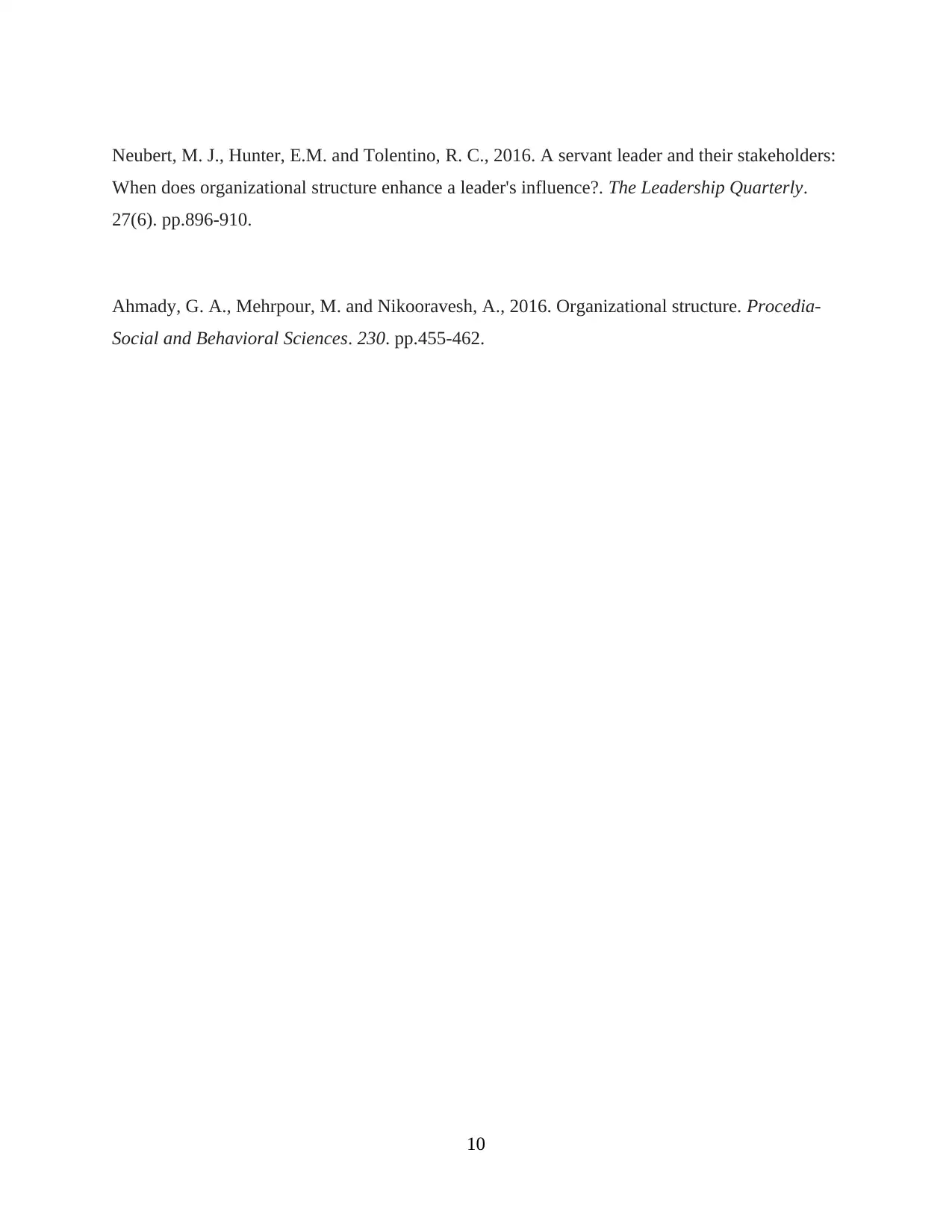
Neubert, M. J., Hunter, E.M. and Tolentino, R. C., 2016. A servant leader and their stakeholders:
When does organizational structure enhance a leader's influence?. The Leadership Quarterly.
27(6). pp.896-910.
Ahmady, G. A., Mehrpour, M. and Nikooravesh, A., 2016. Organizational structure. Procedia-
Social and Behavioral Sciences. 230. pp.455-462.
10
When does organizational structure enhance a leader's influence?. The Leadership Quarterly.
27(6). pp.896-910.
Ahmady, G. A., Mehrpour, M. and Nikooravesh, A., 2016. Organizational structure. Procedia-
Social and Behavioral Sciences. 230. pp.455-462.
10
⊘ This is a preview!⊘
Do you want full access?
Subscribe today to unlock all pages.

Trusted by 1+ million students worldwide
1 out of 12
Related Documents
Your All-in-One AI-Powered Toolkit for Academic Success.
+13062052269
info@desklib.com
Available 24*7 on WhatsApp / Email
![[object Object]](/_next/static/media/star-bottom.7253800d.svg)
Unlock your academic potential
Copyright © 2020–2025 A2Z Services. All Rights Reserved. Developed and managed by ZUCOL.




